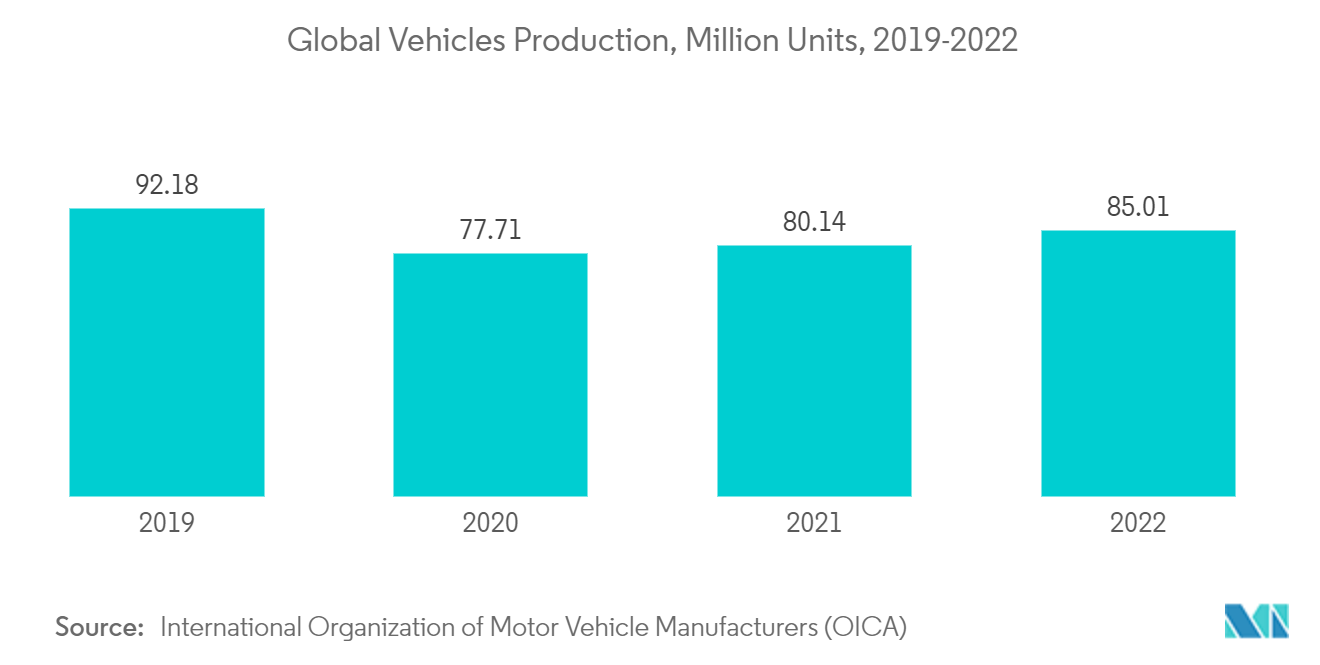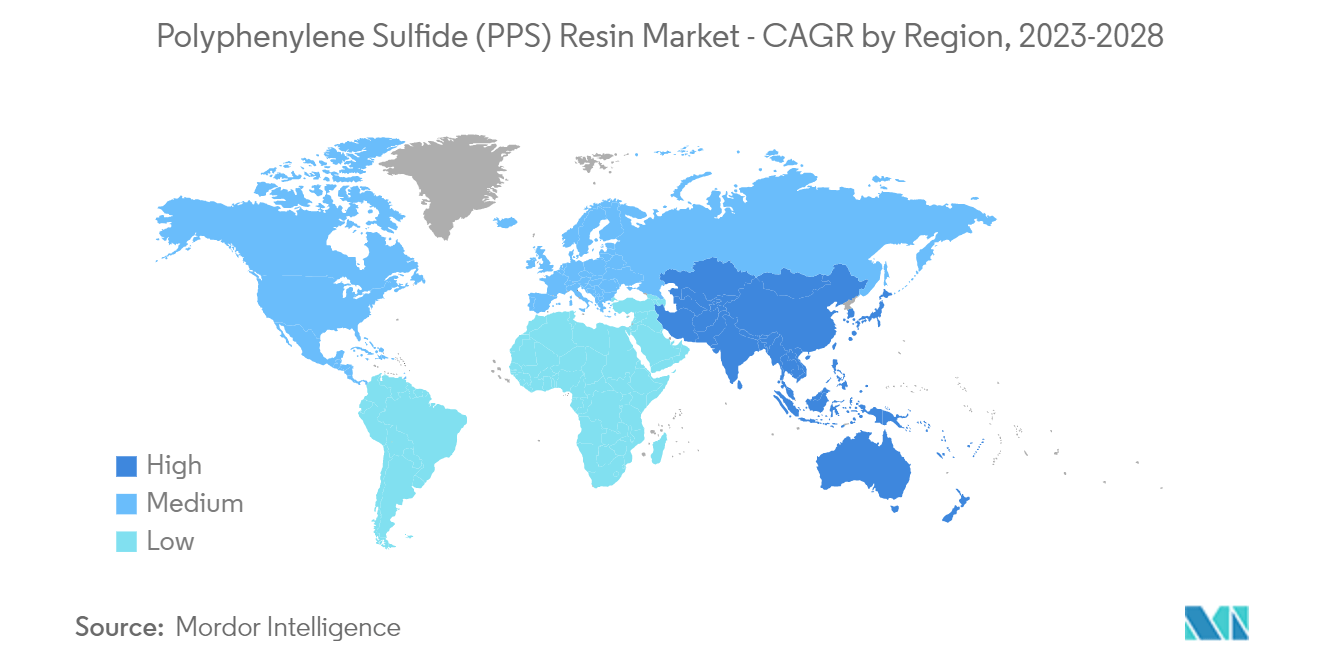Market Trends of Polyphenylene Sulfide (PPS) Resin Industry
Automotive Industry to Dominate the Market
- The automotive sector is the dominating segment due to the extensive consumption of polyphenylene sulfide (PPS) resins in fuel injection systems, coolant systems, and vehicle water pump impellers.
- According to OICA, in 2021, global vehicle production reached 80.1 million units, an increase of 4% from the previous year's 77.6 million units. The increasing production of vehicles owing to the growing need from consumers is the key factor for driving the market growth.
- Polyphenylene sulfide is a high-performance thermoplastic with a maximum crystallinity of 65%. According to International Energy Agency, the total production of thermoplastics is estimated to reach 445.25 million metric tons by 2025.
- Polyphenylene sulfide (PPS) is a semicrystalline material. It offers an excellent balance of properties, including high-temperature resistance, due to which it is also used in the electrical and electronics industry. According to ZVEI, in 2022, the electronics industry in the United States is expected to grow by around 5% year-on-year.
- PPS resin is known for fulfilling requirements such as withstanding elevated temperatures during use and excellent heat cycle performance to be best used in capacitor cases, invertor cores, motor cores, and housings. Due to such properties, PPS resins are used in electric vehicles.
- According to the IEA, the global sales of electric cars in Q1 2022 were 2 million units, up 75% from the same period in 2021. It is expected to reach a further 22% increase of around 1.8 million units by 2023.
- Moreover, heavy investments from automakers are expected to play a significant role in the evolution of the electric vehicle market. For instance, In November 2021, Tesla Inc. announced plans to invest up to USD 187.91 million to expand production capacity at its Shanghai factory.
- In August 2021, Toyota announced its new BEV series, Toyota bZ, which includes a full line-up of electrified vehicles. A concept-first model version in the series was unveiled at Auto Shanghai, and 15 BEVs are expected to be introduced globally by 2025.
- Therefore, the growing automotive industry is expected to fuel the global demand for polyphenylene sulfide (PPS) resin during the forecast period.

Asia-Pacific Region to Dominate the Market
- Asia-Pacific region accounted for the largest market share globally. The demand for PPS is mainly driven by the increasing demand from the automotive, electrical and electronics, industrial, and aerospace industries.
- Asia is the largest automotive manufacturing hub in the world. The development of electric vehicles is expected to continue to gain momentum in the future, especially in China, where many government programs are promoting the move away from fossil fuels, owing to various environmental concerns.
- The Chinese automotive manufacturing industry is the largest in the world. However, the industry witnessed a slowdown in recent years, wherein production and sales declined. According to the China Association of Automobile Manufacturers (CAAM), automotive sales in China fell by 8.4% yoy to 2.56 million units in December 2022, whereas, for the full year 2022, the sales grew to 26.86 million units.
- In 2021, China was the leader in the global auto market, with sales of 26.27 million vehicles, followed by the United States at 15.4 million vehicles and Japan at 4.44 million units.
- According to India Brand Equity Foundation, the Indian car market is expected to reach USD 54.84 billion by 2027, registering a CAGR of over 9%. Indian automotive industry is targeting to increase the export of vehicles five times by the year 2026. In 2022, total automobile exports from India stood at 5,617,246 units.
- The Asia-Pacific region is witnessing numerous investments, primarily from global automakers like BMW, Hyundai Motors, and Honda. These companies plan to venture into the Asia-Pacific automotive industry, primarily to increase production while catering to the increasing demand for advanced automobiles.
- For instance, in December 2022, the BMW Group partnered with Truong Hai Auto Corporation (THACO) to locally produce BMW vehicles in Vietnam. The cooperation extended the BMW Group's production network for vehicles in Asia.
- Furthermore, China has the world's largest production base for electronics. Electronic products, such as smartphones, OLED TVs, tablets, wires, cables, and earphones, are recording the highest growth in electronics.
- According to JEITA (Japan Electronics and Information Technology Industries Association), in November 2022, the total production of the electronics industry reached USD 7,098.34 million. In December 2022, Japan exported electronics worth USD 8,395.45 million.
- The Indian government is mainly focusing on the electronic sector's growth. Thus, it formulated various initiatives, such as a Phased Manufacturing Program (PMP), to add more smartphone components under the 'Make in India' initiative. This is expected to drive domestic manufacturing of mobile handsets, boosting the demand for PPS resins.
- In India, the electronics market witnessed a growth in demand, with market size increasing rapidly. India's electronic goods exports fetched USD 16.67 billion in December 2022, compared to USD 10.99 billion in the same month of 2021.
- Hence, the above market trends are expected to drive the demand for PPS in the region during the forecast period.

